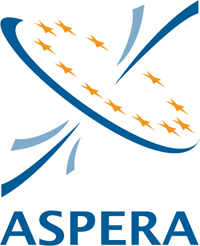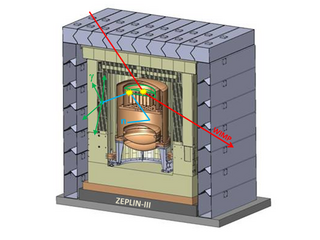Weakly interacting massive particles (WIMPs) are hypothetical particles that are one of the proposed candidates for dark matter.
The Cryogenic Dark Matter Search (CDMS) is a series of experiments designed to directly detect particle dark matter in the form of Weakly Interacting Massive Particles. Using an array of semiconductor detectors at millikelvin temperatures, CDMS has at times set the most sensitive limits on the interactions of WIMP dark matter with terrestrial materials. The first experiment, CDMS I, was run in a tunnel under the Stanford University campus. It was followed by CDMS II experiment in the Soudan Mine. The most recent experiment, SuperCDMS, was located deep underground in the Soudan Mine in northern Minnesota and collected data from 2011 through 2015. The series of experiments continues with SuperCDMS SNOLAB, an experiment located at the SNOLAB facility near Sudbury, Ontario in Canada that started construction in 2018 and is expected to start data taking in early 2020s.
The XENON dark matter research project, operated at the Italian Gran Sasso National Laboratory, is a deep underground research facility featuring increasingly ambitious experiments aiming to detect dark matter particles. The experiments aim to detect particles in the form of weakly interacting massive particles (WIMPs) by looking for rare interactions via nuclear recoils in a liquid xenon target chamber. The current detector consists of a dual phase time projection chamber (TPC).

SNOLAB is a Canadian underground science laboratory specializing in neutrino and dark matter physics. Located 2 km below the surface in Vale's Creighton nickel mine near Sudbury, Ontario, SNOLAB is an expansion of the existing facilities constructed for the original Sudbury Neutrino Observatory (SNO) solar neutrino experiment.
The ArDM Experiment is a particle physics experiment based on a liquid argon detector, aiming at measuring signals from WIMPs, which probably constitute the Dark Matter in the universe. Elastic scattering of WIMPs from argon nuclei is measurable by observing free electrons from ionization and photons from scintillation, which are produced by the recoiling nucleus interacting with neighbouring atoms. The ionization and scintillation signals can be measured with dedicated readout techniques, which constitute a fundamental part of the detector.
Astroparticle physics, also called particle astrophysics, is a branch of particle physics that studies elementary particles of astronomical origin and their relation to astrophysics and cosmology. It is a relatively new field of research emerging at the intersection of particle physics, astronomy, astrophysics, detector physics, relativity, solid state physics, and cosmology. Partly motivated by the discovery of neutrino oscillation, the field has undergone rapid development, both theoretically and experimentally, since the early 2000s.

DEAP is a direct dark matter search experiment which uses liquid argon as a target material. DEAP utilizes background discrimination based on the characteristic scintillation pulse-shape of argon. A first-generation detector (DEAP-1) with a 7 kg target mass was operated at Queen's University to test the performance of pulse-shape discrimination at low recoil energies in liquid argon. DEAP-1 was then moved to SNOLAB, 2 km below Earth's surface, in October 2007 and collected data into 2011.

ASPERA is a network of national government agencies responsible for coordinating and funding national research efforts in astroparticle physics.

The Large Underground Xenon experiment (LUX) aimed to directly detect weakly interacting massive particle (WIMP) dark matter interactions with ordinary matter on Earth. Despite the wealth of (gravitational) evidence supporting the existence of non-baryonic dark matter in the Universe, dark matter particles in our galaxy have never been directly detected in an experiment. LUX utilized a 370 kg liquid xenon detection mass in a time-projection chamber (TPC) to identify individual particle interactions, searching for faint dark matter interactions with unprecedented sensitivity.

The Cryogenic Rare Event Search with Superconducting Thermometers (CRESST) is a collaboration of European experimental particle physics groups involved in the construction of cryogenic detectors for direct dark matter searches. The participating institutes are the Max Planck Institute for Physics (Munich), Technical University of Munich, University of Tübingen (Germany), University of Oxford and the Istituto Nazionale di Fisica Nucleare.

EDELWEISS is a dark matter search experiment located at the Modane Underground Laboratory in France. The experiment uses cryogenic detectors, measuring both the phonon and ionization signals produced by particle interactions in germanium crystals. This technique allows nuclear recoils events to be distinguished from electron recoil events.
A scintillating bolometer is a scientific instrument using particle physics in the search for events with low energy deposition. These events could include dark matter, low energy solar neutrinos, double beta decay or rare radioactive decay. It works by simultaneously measuring both the light pulse and heat pulse generated by a particle interaction within its internal scintillator crystal. The device was originally proposed by L. Gonzalez-Mestres and D. Perret-Gallix

The Canfranc Underground Laboratory is an underground scientific facility located in the former railway tunnel of Somport under Monte Tobazo (Pyrenees) in Canfranc. The laboratory, 780 m deep and protected from cosmic radiation, is mainly devoted to study rarely occurring natural phenomena such as the interactions of neutrinos of cosmic origin or dark matter with atomic nuclei.
The Dark Matter Time Projection Chamber (DMTPC) is an experiment for direct detection of weakly interacting massive particles (WIMPs), one of the most favored candidates for dark matter. The experiment uses a low-pressure time projection chamber in order to extract the original direction of potential dark matter events. The collaboration includes physicists from the Massachusetts Institute of Technology (MIT), Boston University (BU), Brandeis University, and Royal Holloway University of London. Several prototype detectors have been built and tested in laboratories at MIT and BU. The collaboration took its first data in an underground laboratory at the Waste Isolation Pilot Plant (WIPP) site near Carlsbad, New Mexico in Fall, 2010.
The DarkSide collaboration is an international affiliation of universities and labs seeking to directly detect dark matter in the form of weakly interacting massive particles (WIMPs). The collaboration is planning, building and operating a series of liquid argon time projection chambers (TPCs) that are employed at the Gran Sasso National Laboratory in Assergi, Italy. The detectors are filled with liquid argon from underground sources in order to exclude the radioactive isotope 39
Ar, which makes up one in every 1015 (quadrillion) atoms in atmospheric argon. The Darkside-10 (DS-10) prototype was tested in 2012, and the Darkside-50 (DS-50) experiment has been operating since 2013. Darkside-20k (DS-20k) with 20 tonnes of liquid argon is being planned as of 2019.

The ZEPLIN-III dark matter experiment attempted to detect galactic WIMPs using a 12 kg liquid xenon target. It operated at the Boulby Underground Laboratory in the period 2006–2011. This was the last in a series of xenon-based experiments in the ZEPLIN programme pursued originally by the UK Dark Matter Collaboration (UKDMC). The ZEPLIN-III project was led by Imperial College London and also included the Rutherford Appleton Laboratory and the University of Edinburgh in the UK, as well as LIP-Coimbra in Portugal and ITEP-Moscow in Russia. It ruled out cross-sections for elastic scattering of WIMPs off nucleons above 3.9 × 10−8 pb from the two science runs conducted at Boulby.

The MAJORANA project is an international effort to search for neutrinoless double-beta (0νββ) decay in 76Ge. The project builds upon the work of previous experiments, notably those performed by the Heidelberg–Moscow and IGEX collaborations, which used high-purity germanium (HPGe) detectors, to study neutrinoless double-beta decay.
ANAIS is a particle detector experiment designed to detect dark matter. ANAIS stands for Annual modulation with NAI Scintillators. Its main goal is the direct detection of the dark matter through its scattering off the target nuclei in a radiopure NaI (Tl) crystal. This dark matter signal should be annually modulated by the change in the relative velocity of WIMP-nucleus, a result of the rotation of the Earth around the Sun.
The Korea Invisible Mass Search (KIMS), is a South Korean experiment, led by Sun Kee Kim, searching for weakly interacting massive particles (WIMPs), one of the candidates for dark matter. The experiments use CsI(Tl) crystals at Yangyang Underground Laboratory (Y2L), in tunnels from a preexisting underground power plant. KIMS is supported by the Creative Research Initiative program of the Korea Science and Engineering Foundation. It is the first physics experiment located, and largely built, in Korea.
The Cryogenic Low-Energy Astrophysics with Noble liquids (CLEAN) experiment by the DEAP/CLEAN collaboration is searching for dark matter using noble gases at the SNOLAB underground facility. CLEAN has studied neon and argon in the MicroCLEAN prototype, and running the MiniCLEAN detector to test a multi-ton design.










